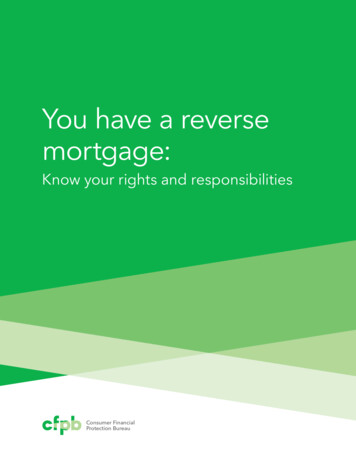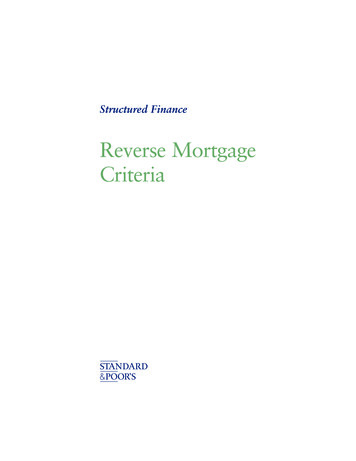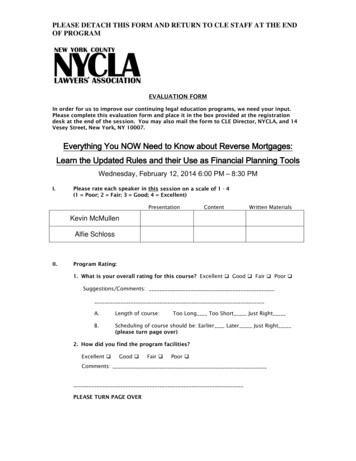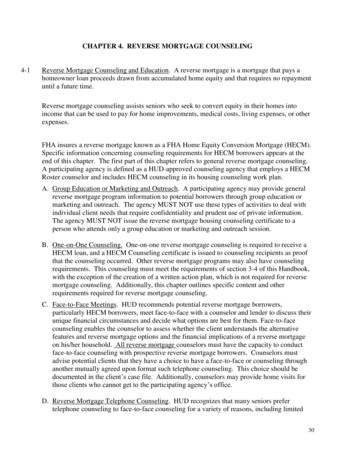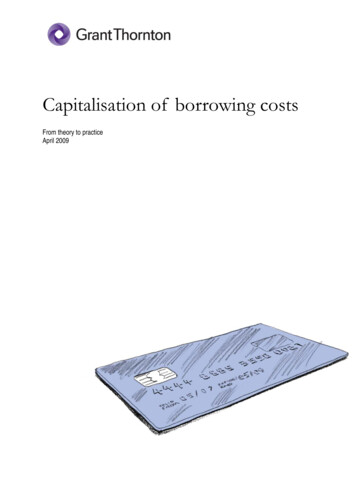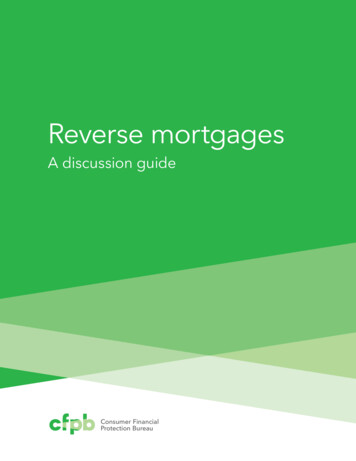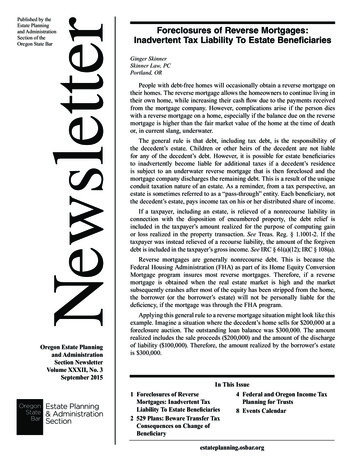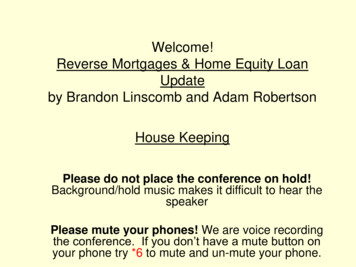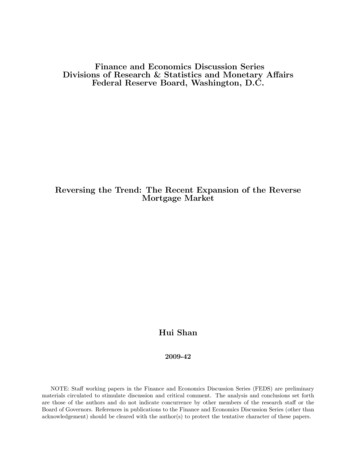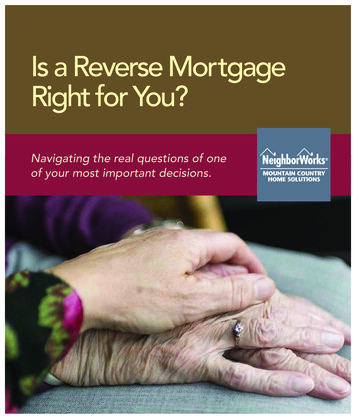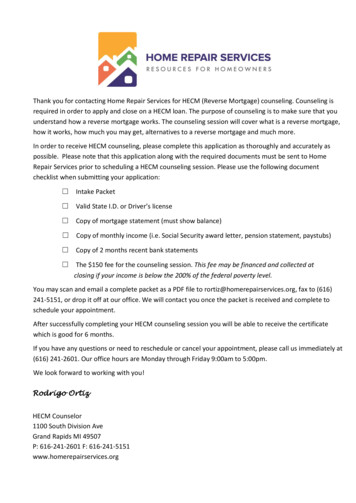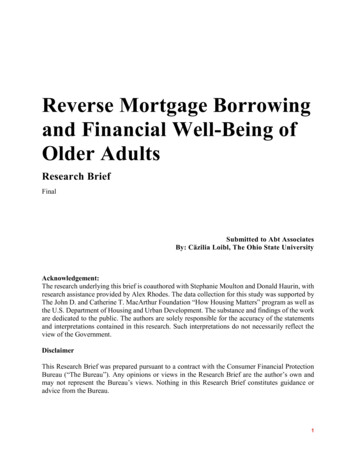
Transcription
Reverse Mortgage Borrowingand Financial Well-Being ofOlder AdultsResearch BriefFinalSubmitted to Abt AssociatesBy: Cäzilia Loibl, The Ohio State UniversityAcknowledgement:The research underlying this brief is coauthored with Stephanie Moulton and Donald Haurin, withresearch assistance provided by Alex Rhodes. The data collection for this study was supported byThe John D. and Catherine T. MacArthur Foundation “How Housing Matters” program as well asthe U.S. Department of Housing and Urban Development. The substance and findings of the workare dedicated to the public. The authors are solely responsible for the accuracy of the statementsand interpretations contained in this research. Such interpretations do not necessarily reflect theview of the Government.DisclaimerThis Research Brief was prepared pursuant to a contract with the Consumer Financial ProtectionBureau (“The Bureau”). Any opinions or views in the Research Brief are the author’s own andmay not represent the Bureau’s views. Nothing in this Research Brief constitutes guidance oradvice from the Bureau.1
Executive SummaryUnderstanding the financial well-being of older adults is increasingly important as concerns aboutinsufficient retirement savings and debt burdens grow. The primary asset for many older adults isthe equity in their homes—yet home equity is illiquid and can only be accessed by selling the homeor borrowing through a mortgage. Most older adults express a strong desire to remain in theirhomes, yet some cannot afford monthly payments associated with borrowing through a mortgage.Reverse mortgages allow older adults to access the equity in their homes without repayment untilthe termination of the loan. The most widely used reverse mortgage product is offered by theFederal Housing Administration’s Home Equity Conversion Mortgage (HECM) program, firstinitiated in the Housing and Community Development Act of 1987 (Pub.L. 100-242). Reversemortgages are designed to improve the financial stability of adults age 62 and older by providinga way to “supplement Social Security, meet unexpected medical expenses and make homeimprovements” (HUD, 2006). Despite potential benefits, reverse mortgages have been widelycriticized and hold a negative public image. Reasons include the costs associated with obtaining aHECM loan, a general aversion to mortgage debt, a desire to pass the home on to heirs, and thehigh complexity of this financial product.The purpose of this study is to explore the financial well-being of older adults who hold reversemortgages. How does the financial well-being of reverse mortgage borrowers compare to thefinancial well-being of otherwise similar older adults without reverse mortgages? What borrowercharacteristics at the time of pre-reverse mortgage counseling are associated with higher and lowerlevels of financial well-being two to five years after originating the loan? How is the amount ofthe initial withdrawal from the reverse mortgage related to subsequent financial well-being?We use several survey and administrative data sets. They include the Aging in Place survey, anational data set of reverse mortgage borrowers collected by the research team from April to July2017. A total of 380 respondents answered the Financial Well-Being short scale items, which werecollected two to five years after loan origination. The Aging in Place survey is merged with HUDreverse mortgage counseling data, the National Council on Aging’s Financial Interview Tool data,the borrower’s credit score, and HECM loan data from the U.S. Department of Housing and UrbanDevelopment. In addition, we use the National Financial Well-Being survey of respondents age62 and older who own a home.Key findings are: The Financial Well-Being score of older reverse mortgage borrowers is about six pointslower than the score of older homeowners of the general population. However, thisdifference is primarily due to differences in financial and socio-demographiccharacteristics. Holding constant these characteristics, the Financial Well-Being scores ofolder reverse mortgage borrowers do not significantly differ from the Financial Well-Beingscores of older homeowners in the general population. Credit score at the time of required pre-reverse mortgage counseling is positivelyassociated with Financial Well-Being scores two to five years after reverse mortgageorigination in the reverse mortgage sample. Other financial indicators at the time of2
counseling, including those collected as part of the Financial Interview Tool score, are notsignificantly associated with higher Financial Well-Being scores in later years. Withdrawals of reverse mortgage proceeds at loan origination, whether used to pay-off aprior mortgage (mandatory withdrawal) or for other purposes (discretionary withdrawal),do not predict Financial Well-Being scores two to five years later. Two other indicators ofreverse mortgage borrowing are associated with higher Financial Well-Being scores: alimit) and lower mortgage debt at origination.The findings from this study inform both research and practice. This study contributes to anunderstanding of the longer-term financial wellbeing outcomes of reverse mortgage borrowers.Most national survey samples do not identify reverse mortgages or lack a sufficient sample ofreverse mortgage borrowers for meaningful analysis—this being an advantage of the Aging inPlace survey. For practice, the findings of this study indicate that credit scores at the time of prereverse mortgage counseling can serve as a meaningful tool to predict reverse mortgage borrowers’financial well-being in future years. These lower credit score borrowers may benefit fromadditional resources and support before and after closing on the reverse mortgage. This supportcould be provided by counseling agencies, lenders, or the Federal Housing Administration.1. BackgroundThe primary aim of this study is to understand the financial well-being of older adults who borrowthrough a reverse mortgage. The most widely used reverse mortgage is the Federal HousingAdministration’s Home Equity Conversion Mortgage (HECM), with more than 1.13 million loansoriginated through August of 2019. Although a relatively small share of the eligible population ofhomeowners holds a reverse mortgage, this is a critical population given the growing levels of debtand limited assets of older adults—the primary form of which is held as home equity among manyolder adults (Moulton et al., 2017; The Federal Reserve Board, 2016).Considerable heterogeneity in financial well-being has been identified in a national sample ofreverse mortgage borrowers. While the mean standardized Financial Well-Being score of thereverse mortgage borrowers in this sample is 55, scores range from 37 at the 10th percentile of thedistribution of respondents to 76 at the 90th percentile. Compared to the general population, a scoreof 37 is considered a “low” Financial Well-Being score and a score of 76 is considered a “veryhigh” Financial Well-Being score (CFPB, 2019).In this research study, we estimate the extent to which this variation in financial well-being isassociated with demographic and financial characteristics of borrowers at the time of themandatory pre-reverse mortgage counseling session. Our administrative data at the time ofcounseling include individual level responses to the National Council on Aging’s FinancialInterview Tool. Starting in 2010, the Financial Interview Tool was a required part of counselingfor almost nine years. The tool was intended to help counselors identify older adults for whom thereverse mortgage may be a poor financial solution based on their housing, health, and financialstatus. In line with the capability framework (CFPB, 2018), an objective of our study is to identifyhow these factors at the time of counseling are associated with financial well-being later in life.Our data allow us to examine a range of factors, including detailed reverse mortgage borrowing3
data, socio-demographic characteristics, financial status, health situation, and housingcharacteristics. No research to date has analyzed the extent to which these potential factors predictsubsequent financial well-being for reverse mortgage borrowers.Aside from borrower characteristics, we estimate the extent to which the percent of availableequity withdrawn up-front on a reverse mortgage is associated with subsequent financial wellbeing. We consider two separate components of the amount withdrawn—the amount to pay offforward mortgage debt (required withdrawal) and the amount of additional discretionary fundstaken as a lump sum at closing (discretionary withdrawal). Prior studies have found that an increasein the initial discretionary withdrawal of the reverse mortgage is associated with an increased riskof default on property taxes and homeowners insurance (IFE, 2014; Moulton et al., 2015).Taken together, this study provides new, original knowledge to research and practice bycontributing to the understanding of the longer-term outcomes of reverse mortgage borrowing.Second, this study introduces the Financial Well-Being scale to researchers in the large fields ofaging and housing research. Most importantly, for practice, this study informs about factorsidentified at the time of the mandatory reverse mortgage counseling session that are associatedwith subsequent lower levels of financial well-being. These factors can be used to tailorinformation and resources to prospective borrowers.2. About the StudyThis research informs the following questions:RQ1: How does the financial well-being of reverse mortgage borrowers compare to the financialwell-being of otherwise similar older adults who own their homes and do not have reversemortgages?RQ2: How are various financial, housing, health and socio-demographic characteristics ofreverse mortgage borrowers at the time of reverse mortgage counseling associated withfinancial well-being among two to five years later?RQ3: How is the initial withdrawal (for both mortgage debt and other purposes) from the reversemortgage related to subsequent financial well-being?To inform our research questions, we begin with a descriptive comparison of the characteristics ofreverse mortgage borrowers relative to older adults in the general population. We then comparethe financial well-being of reverse mortgage borrowers to older adults with otherwise similarfinancial and demographic characteristics. Next, we conduct descriptive comparisons of meansand multivariate regression analysis to identify the factors at the time of counseling that areassociated with subsequent higher and lower levels of financial well-being. Finally, we estimatethe extent to which the amount of the initial withdrawal is associated with subsequent financialwell-being, treating the amount of the withdrawal as an endogenous choice.We use several survey and administrative data sets. First, we use the Aging in Place survey, anational survey of reverse mortgage borrowers conducted by the research team from April to July2017. This was a second wave of the survey previously administered by the research team in4
2014/15 (Moulton et al., 2017). The second wave of the Aging in Place survey data collectionstarted four months after the National Financial Well-Being survey was completed, which wascollected from October to December 2016 (CFPB, 2017). The second wave of the Aging in Placesample consists of 411 adults aged 62 and older who obtained a reverse mortgage between twoand five years prior to the survey.Second, the Aging in Place survey is merged with four administrative, client-level data setscollected at counseling and subsequent loan origination: 1) reverse mortgage counseling data fromthe U.S. Department of Housing and Urban Development; 2) reverse mortgage borrower loan datafrom the U.S. Department of Housing and Urban Development; 3) the National Council onAging’s Financial Interview Tool; and 3) the reverse mortgage borrowers’ credit score at loanorigination. For a comparison sample, we use the National Financial Well-Being survey ofrespondents age 62 and older who own a home.The Aging in Place sample includes respondents who were counseled for a reverse mortgage byClearpoint Credit Counseling Solutions, a national, HUD-approved 501(c)(3) nonprofit housingcounseling agency. Reverse mortgage borrowers who received pre-reverse mortgage counselingfrom Clearpoint between January 2012 and April 2015 (n 4,624) are included in the second waveof the Aging in Place survey. Of this group, 3,546 had accurate contact information for the followup survey; 411 borrowers completed the survey. Of those, 380 survey respondents had non-missingdata for the Financial Well-Being score. The comparison group are respondents of the FinancialWell-Being survey age 62 and older who own their home, a total of 1,909 respondents.3. Findings3.1.How does the financial well-being of reverse mortgage borrowers compare to thefinancial well-being of otherwise similar older adults who own their homes and do nothave reverse mortgages?We first compare the Financial Well-Being score of reverse mortgage borrowers two-to-five yearsafter they receive the reverse mortgage to that of older homeowners in the general population. Wefind that reverse mortgage borrowers have an average score of 56 compared to an average scoreof 62 for older homeowners in the general population—a difference that is statistically significant.It is not surprising that reverse mortgage borrowers have lower Financial Well-Being scores giventhat they have lower incomes and financial wealth than older adults in the general population. Forexample, the median income of reverse mortgage borrowers is 3,477, compared to 6,242 forolder homeowners in the general population.We next measure the Financial Well-Being scores of reverse mortgage borrowers relative to olderhomeowners in the general population who are similar to reverse mortgage borrowers with regardto key financial and socio-demographic characteristics. To do this, we create weights that representthe likelihood of being in the reverse mortgage sample, and then include these weights in our dataso that the respondents in the general population are more similar to respondents in our reversemortgage sample with regard to gender, age, race, marital status, household size, educationalattainment, income, ownership of financial and retirement savings, and home value. After applying5
the weights, we observe that the Financial Well-Being score of reverse mortgage borrowers is notstatistically different from that of older homeowners with similar characteristics who do not holda reverse mortgage.3.2.How are various financial, housing, health and socio-demographic characteristics ofreverse mortgage borrowers at the time of reverse mortgage counseling associated withfinancial well-being two to five years later?We next present findings on the relationship between characteristics of reverse mortgageborrowers at the time of pre-origination counseling and Financial Well-Being scores two-to-fiveyears after origination. The CFPB defines Financial Well-Being scores below 50 to be indicativeof financial vulnerability (CFPB, 2017), and we thus use a score of 50 as the threshold for thiscomparison. In our sample of reverse mortgage borrowers, 33 percent have Financial Well-Beingscores below 50, compared to 67 percent with Financial Well-Being scores of 50 and higher.First, reverse mortgage borrowers with lower credit scores at the time of origination of the reversemortgage have lower Financial Well-Being scores two to five years later. The mean difference incredit scores between those with lower to those with higher levels of Financial Well-being is 49points and it is statistically significant; the significant relationship is confirmed in multivariateregression analysis and aligns with findings for the general population (Nagypál & Tobacman,2019).Figure 1 illustrates the association of credit score and Financial Well-Being score. In this figure,Financial Well-Being scores are categorized in buckets, following a recent “toolkit” report of theCFPB (2019). The credit scores are split at the 680 score mark, which represents a thresholdfrequently used in mortgage underwriting to indicate a good credit score. The figure documentsthat reverse mortgage borrowers with good credit scores at origination are more likely to havehigher Financial Well-Being scores in later years. For example, of the reverse mortgage borrowersin the “high” Financial Well-Being score range of 58 to 67, 72% have a credit score of 680 orhigher.6
Figure 1: Alignment of Financial Well-Being score and credit score among reverse mortgageborrowersWe next identify the extent to which the responses on the Financial Interview Tool administeredat the time of counseling are associated with subsequent financial well-being. The FinancialInterview Tool is a 43-item questionnaire that results in an overall risk score. Our results indicatethat there was no statistical difference in the average Financial Interview Tool risk score of reversemortgage borrowers at the time of origination with lower and higher FWB scores two and fiveyears later. Similarly, the Financial Interview Tool score does not predict the Financial Well-Beingscore in a multivariate regression analysis.However, in addition to the overall risk score that is assessed by 19 questions of the 43-questionFinancial Interview Tool, we also looked at the relationship between individual items on theFinancial Interview Tool and financial well-being. Responses to individual Financial InterviewTool questions show that those with lower health, a greater need to pay off debt with reversemortgage proceeds, lesser flexibility to invest the reverse mortgage proceeds, and plans to stay intheir home at least the next three years at the time of counseling were statistically more likely tohave lower financial well-being two-to-five years later.Third, we investigate the extent to which socio-demographic characteristics are associated withlower and higher subsequent Financial Well-Being scores. Race is the only significantly differentdemographic indicator, with a larger proportion of borrowers who are black having higherFinancial Well-Being scores, despite having lower credit scores (on average, their credit score is653; the difference is 60 points). This finding is confirmed in multivariate regression analysis.We observe no significant differences in the financial characteristics of borrowers with lowerversus higher Financial Well-Being scores.7
3.3.How is the initial withdrawal (for both mortgage debt and other purposes) from thereverse mortgage related to subsequent financial well-being?The third research question examines the association of required and discretionary withdrawalsfrom the reverse mortgage loan at loan origination with the Financial Well-Being score two to fiveyears past origination. During our study period, HUD initiated a policy change that limited theamount of the up-front withdrawal to 60 percent of available proceeds, with exceptions for higherdraw amounts if needed to pay-off a forward mortgage. We model the discretionary withdrawalamount as an endogenous choice variable, using as instruments the policy changes in April andOctober 2013 that limited the withdrawal amount.The regression results show that the proportion of funds withdrawn by borrowers at the time oforigination is not significantly associated with the Financial Well-Being score two to five yearslater. This is true regardless of whether the money is withdrawn to pay off a mortgage (mandatory)or for other reasons. However, the regression results show that an overall higher loan limit on thereverse mortgage (the initial principal limit) is associated with a higher subsequent Financial WellBeing score at the 10 percent significance level. Holding a larger amount of mortgage debt priorto originating the reverse mortgage is associated with a lower Financial Well-Being score, this atthe 5 percent significance level. It is important to caution that these associations are not causal.For example, we do not observe the financial well-being of reverse mortgage borrowers prior tooriginating a reverse mortgage, and we thus do not know if those with higher levels of mortgagedebt also had lower levels of financial well-being before originating a reverse mortgage.8
4. ConclusionThe findings from this study inform both research and practice. First, this study contributes to anunderstanding of the longer-term financial wellbeing outcomes of reverse mortgage borrowers.Most national survey samples do not identify reverse mortgages or lack a sufficient sample ofreverse mortgage borrowers for meaningful analysis—this being an advantage of the Aging inPlace survey. For practice, the findings of this study indicate that credit scores at the time of prereverse mortgage counseling can serve as a meaningful indicator to predict reverse mortgageborrowers’ financial well-being in future years. A secondary indicator of future financial wellbeing is traditional forward mortgage debt at time of reverse mortgage origination. These lowercredit score, higher mortgage debt borrowers may benefit from additional resources and supportbefore and after closing on the reverse mortgage. This support could be provided by counselingagencies, lenders, or even the Federal Housing Administration.ReferencesCFPB. (2017). Financial Well-Being in America. Washington: Consumer Financial Protection Bureau.CFPB. (2018). Pathways to Financial Well-Being: The Role of Financial Capability. Washington: Bureauof Consumer Financial Protection.CFPB. (2019). Getting Started with Measuring Financial Well-Being: A Toolkit for Financial Educators.Washington: Bureau of Consumer Financial Protection.HUD. (2006). HUD Strategic Plan FY 2006 - FY 2011. Washington: U.S. Department of Housing andUrban Development.IFE. (2014). Actuarial Review of the Federal Housing Administration Mutual Mortgage Insurance FundHecm Loans for Fiscal Year 2014. Washington: U.S. Department of Housing and UrbanDevelopment: Integrated Financial Engineering.Moulton, S., Haurin, D., & Shi, W. (2015). An Analysis of Default Risk in the Home Equity ConversionMortgage (Hecm) Program. Journal of Urban Economics, 90(November), 17-34.Moulton, S., Loibl, C., & Haurin, D. (2017). Reverse Mortgage Motivations and Outcomes: Insights fromSurvey Data. CityScape, 19(1), 73-98.Nagypál, É., & Tobacman, J. (2019). Credit Characteristics, Credit Engagement Tools, and FinancialWell-Being. Washington: Consumer Financial Protection Bureau.The Federal Reserve Board. (2016). Survey of Consumer Finances. Washington: Board of Governors ofthe Federal Reserve System.9
2017. A total of 380 respondents answered the Financial Well -Being short scale items , which were collected two to five years after loan origination. The Aging in Place survey is merged with HUD . While the mean standardized -Being score of the Financial Well reverse mortgage borrowers in this sample is 55, scores range from 37 at the 10. th .
